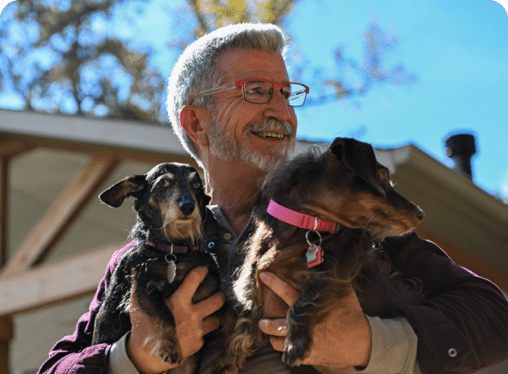Treatment Naïve Adults, including
Clinical Trial Experience

Broad Experience in Clinical Trials and Proven Results1-7
The efficacy and safety profile of BIKTARVY is backed by robust clinical trial experience in a diverse range of people1-7
Over 3600 participants and up to 5 years of follow-up in clinical trials1-4,6-9
BIKTARVY has been extensively studied across1,5,7,10,11:

- Various races and ethnicities*
- High baseline viral loads
(HIV RNA >100k copies/mL) - Low CD4 counts
(CD4 cell count <200 cells/μL)

Virologically Suppressed PWH,
including
- Adults with known or suspected M184V/I resistance mutation
- Various races and ethnicities*
- Black American Adults
- Adults assigned female at birth†
- Adults ≥65 years
- Children and adolescents

Additional Understudied Populations
- Virologically suppressed pregnant adult women
- Virologically suppressed adults with ESRD receiving chronic hemodialysis‡
- Mild to moderate renal impairment (estimated CrCl ≥30 mL/min)
People featured are real patients who take BIKTARVY and are compensated by Gilead; they did not participate in clinical trials.
*Including Black, White, Hispanic/Latino, and Asian populations.
†Including adults, adolescents, and children.
‡In Trial 1825, an open-label, single-arm trial, virologically suppressed adults with ESRD (estimated CrCl <15 mL/min) on chronic hemodialysis were given FTC/TAF in combination with elvitegravir and cobicistat for 96 weeks (N=55). In a 48-week extension, 10 study participants switched to BIKTARVY.
182 virologically suppressed study participants across 6 clinical trials with preexisting M184V/I resistance mutation, including12:
20% (n=47/238) of participants who had M184V/I resistance mutation at baseline in Study 403013
Of the participants with known M184V/I:
were identified through
historical genotype
were identified through
proviral DNA
BIKTARVY was studied across 9 phase 3 clinical trials in treatment-naïve and virologically suppressed study participants1,6,7
Treatment-Naïve Studies
Study 1489
Adults
BIKTARVY (n=314) vs
ABC/DTG/3TC (n=315)
(n=254) switched to BIKTARVY at Week 144
View Study 1489Study 1490
Adults
BIKTARVY (n=320) vs
DTG+FTC/TAF (n=325)
(n=265) switched to BIKTARVY at Week 144
View Study 1490Virologically Suppressed Studies
Study 1844
Adults
Switched to BIKTARVY (n=282) or continued on ABC/DTG/3TC
(n=281)
(n=265) switched to BIKTARVY at Week 48
View Study 1844Study 1878
Adults
Switched to BIKTARVY (n=290) or stayed on baseline regimen‡ (n=287)
(n=244) switched to BIKTARVY at Week 48
View Study 1878Study 4030
Adults, Including Those
With Known or Suspected
Preexisting M184V/I
Resistance Mutation
Switched to BIKTARVY (n=284) or continued on
DTG+FTC/TAF (n=281)
Study 1961
Adult Women
Switched to BIKTARVY (n=234) or stayed on baseline regimen§ (n=236)
(n=228) switched to BIKTARVY at Week 48
View Study 1961BRAAVE
Black American Adults
Switched to BIKTARVY (n=330)or stayed on stable baseline regimen (n=165) with delayed switch to BIKTARVY at Week 24 (n=163)
View BRAAVEStudy 5310
A Phase 1 Trial in Virologically Suppressed Pregnant Adult Women
Switched to BIKTARVY
(n=33)
BIKTARVY is being studied in additional clinical trials, including:
BICSTaR: Ongoing multicountry, multicenter, prospective observational cohort study aimed to evaluate the effectiveness and safety of treatment with BIKTARVY with enrollment of over 2300 people living with HIV.16,17
Select BIKTARVY DHHS guidelines recommendations:
BIKTARVY is DHHS guidelines–recommended14,15
- As an initial regimen for most people living with HIV
- In virologically suppressed people with M184V/I resistance mutation (BIII)*
- As a preferred initial regimen for children ≥2 years old (≥14 kg)
-
BIKTARVY is DHHS guidelines–recommended for PWH with adherence challenges14
- Other considerations include side effects, out-of-pocket costs, convenience, and patient preferences14
- Continue to counsel your patients to take BIKTARVY once daily.1
*Rating of recommendation: B=Moderate. Rating of evidence: III=Expert opinion.
‡ABC/3TC or FTC/TDF + boosted ATV or DRV regimen (cobicistat or ritonavir).
§E/C/F/TAF or E/C/F/TDF or ATV+RTV+FTC/TDF.
||Switched from E/C/F/TAF or F/TDF + a third agent.
¶Open-label, single-arm trial included virologically suppressed adolescents, aged ≥12 to <18 years weighing at least 35 kg (n=50), virologically suppressed children aged ≥6 to <12 years weighing at least 25 kg (n=50), and virologically suppressed children, aged ≥2 years and weighing at least 14 kg (n=22).1
3TC, lamivudine; ABC, abacavir; ATV, atazanavir; BICSTaR, bictegravir single-tablet regimen; C, cobicistat; CD4, cluster of differentiation 4; DRV, darunavir; DTG, dolutegravir; E, elvitegravir; FTC, emtricitabine; RNA, ribonucleic acid; RTV, ritonavir; TAF, tenofovir alafenamide; TDF, tenofovir disoproxil fumarate.
References: 1. BIKTARVY. Prescribing information. Gilead Sciences, Inc.; 2024. 2. Wohl DA, Pozniak A, Workowski K, et al. B/F/TAF five-year outcomes in treatment-naïve adults. Poster presented at: Conference on Retroviruses and Opportunistic Infections; February 12-16, 2022; Virtual. Poster 494. 3. Brar I, Ruane P, Ward D, et al. Long-term follow-up after a switch to bictegravir, emtricitabine, and tenofovir alafenamide from dolutegravir, abacavir, and lamivudine. Poster presented at: IDWeek; October 21-25, 2020; Virtual. Poster 1028. 4. Rockstroh J, Molina J-M, Post F, et al. Long-term follow-up after a switch to bictegravir, emtricitabine, tenofovir alafenamide (B/F/TAF) from a boosted protease inhibitor-based regimen. Poster presented at: HIV Drug Therapy Glasgow 2020; October 5-8, 2020; Virtual. Poster P036. 5. Kityo C, Hagins D, Koenig E, et al. Switching to fixed-dose bictegravir, emtricitabine, and tenofovir alafenamide (B/F/TAF) in virologically suppressed HIV-1 infected women: a randomized, open-label, multicenter, active-controlled, Phase 3, noninferiority trial. J Acquir Immune Defic Syndr. 2019;82(3):321-328. 6. Kityo C, Hagins D, Koenig E, et al. Longer-term (96-week) efficacy and safety of switching to bictegravir, emtricitabine, and tenofovir alafenamide (B/F/TAF) in women. Oral presentation at: International AIDS Society Conference on HIV Science 2019; July 21-24, 2019; Mexico City, Mexico. Abstract MOAB0106. 7. Kumar P, Stephens JL, Wurapa AK, et al. Week 72 outcomes and COVID-19 impact from the BRAAVE 2020 study: a randomized switch to B/F/TAF in Black American adults with HIV. Poster presented at: International AIDS Society Conference on HIV Science; July 18-21, 2021; Virtual. Poster PEB161. 8. Maggiolo F, Rizzardini G, Molina J-M, et al. Bictegravir/emtricitabine/tenofovir alafenamide in virologically suppressed people with HIV aged ≥65 years: week 48 results of a Phase 3b, open-label trial. Infect Dis Ther. 2021;10(2):775-788. 9. Natukunda E, Rodriguez CA, McGrath EJ, et al. B/F/TAF in virologically suppressed adolescents and children: two-year outcomes in 6 to <18 year olds and six-month outcomes in toddlers. Abstract presented at: International Workshop on HIV & Pediatrics. July 16-17, 2021; Virtual. Abstract 2. 10. Gallant J, Lazzarin A, Mills A, et al. Bictegravir, emtricitabine, and tenofovir alafenamide versus dolutegravir, abacavir, and lamivudine for initial treatment of HIV-1 infection (GS-US-380-1489): a double-blind, multicentre, Phase 3, randomised controlled non-inferiority trial. Lancet. 2017;390(10107):2063-2072. 11. Sax PE, Pozniak A, Montes ML, et al. Coformulated bictegravir, emtricitabine, and tenofovir alafenamide versus dolutegravir with emtricitabine and tenofovir alafenamide, for initial treatment of HIV-1 infection (GS-US-380-1490): a randomised, double-blind, multicentre, Phase 3, non-inferiority trial. Lancet. 2017;390(10107):2073-2082. 12. Sax PE, Andreatta K, Molina J-M, et al. High efficacy of switching to bictegravir/emtricitabine/tenofovir alafenamide in people with suppressed HIV and preexisting M184V/I. AIDS. 2022;36(11):1511-1520. 13. Acosta RK, Willkom M, Andreatta K, et al. Switching to bictegravir/emtricitabine/tenofovir alafenamide (B/F/TAF) from dolutegravir (DTG)+F/TAF or DTG+F/tenofovir disoproxil fumarate (TDF) in the presence of pre-existing NRTI resistance. J Acquir Immune Defic Syndr. 2020;85(3):363-371. 14. Panel on Antiretroviral Guidelines for Adults and Adolescents. Guidelines for the use of antiretroviral agents in adults and adolescents with HIV. Department of Health and Human Services. Updated September 12, 2024. Accessed September 24, 2024. https://clinicalinfo.hiv.gov/sites/default/files/guidelines/documents/adult-adolescent-arv/guidelines-adult-adolescent-arv.pdf 15. Panel on Antiretroviral Therapy and Medical Management of Children Living with HIV. Guidelines for the Use of Antiretroviral Agents in Pediatric HIV Infection. Department of Health and Human Services. Updated June 27, 2024. Accessed September 24, 2024. https://clinicalinfo.hiv.gov/sites/default/files/guidelines/documents/pediatric-arv/guidelines-pediatric-arv.pdf 16. Spinner CD, Stoehr A, Wong A, et al. Starting or switching to bictegravir/emtricitabine/tenofovir alafenamide (B/F/TAF) in clinical practice: pooled 12-month results from the global BICSTaR study. Poster presented at: HIV Glasgow 2020; October 5-8, 2020; Glasgow, UK. Poster P046K. 17. Trottier B, Antinori A, De Wet J, et al. Bictegravir/emtricitabine/tenofovir alafenamide (B/F/TAF) for the treatment of people living with HIV: 24-month analyses by age, race, sex, adherence and late diagnosis in a multi-country cohort study. Poster presented at: HIV Glasgow 2022; October 23-26, 2022; Glasgow, UK. Poster P067.

